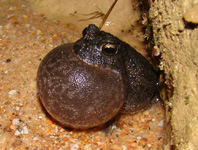Abstract
Cliona tumula sp. nov. is described from the Florida Keys, Florida, USA. The new species is compared to representative Cliona spp. from the Caribbean and Indo-Pacific. Cliona tumula sp. nov. is a massive, mound-shaped zooxanthellate clionaid with a central, apical cluster of numerous oscula, slender tylostyles with variable heads and abundant, delicate spirasters with compound spines that can be concentrated at the ends, which in this species can appear as mushroom-like caps, with a skeleton in typical clionaid arrangement. It is distinguished from congeners by its epibenthic growth form that extends for 20–40 cm above the substratum, centrally located concentration of oscula, and calcareous fragments obtained from surrounding sediment that C. tumula sp. nov. incorporates in tracts that run through the choanosome perpendicular to the ectosome. This species can be locally abundant in the Florida Keys in patch reefs near sand flats, but may be restricted to the lower keys as it has not been observed on reefs to the east.

